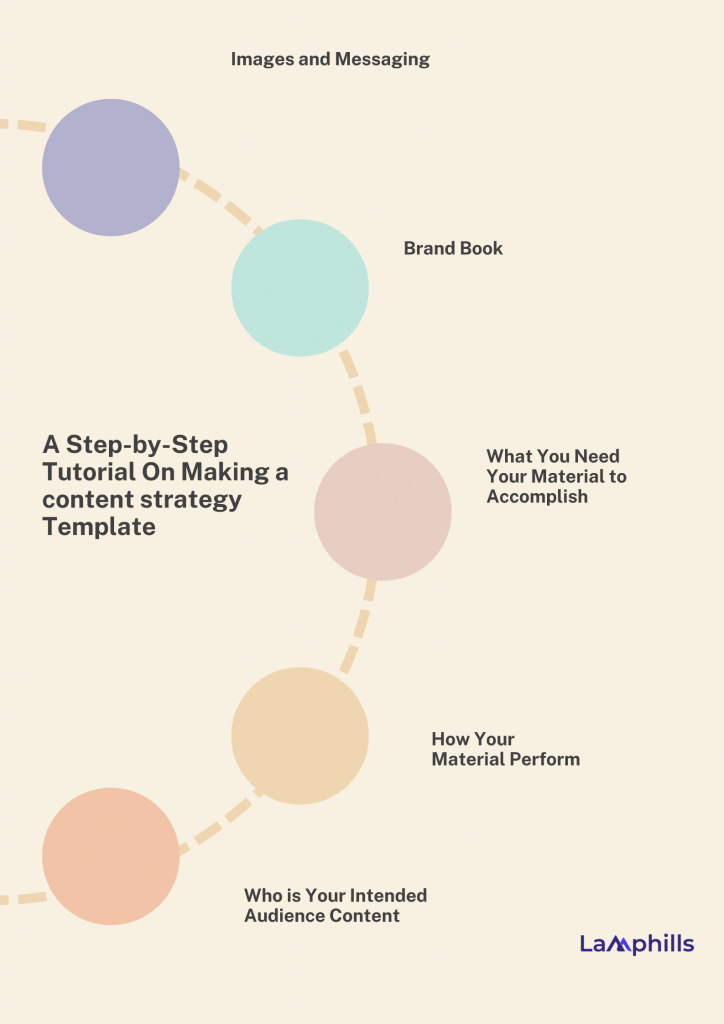A successful content strategy template involves producing the correct type of material for your intended audience. I understand that being in charge of content marketing can quickly become overwhelming.
You are responsible for managing campaigns across numerous channels, each with its own set of contributors, team members, resources, and deadlines. You need a location to arrange every process component so you can feel prepared and confident throughout.
Well, I have got you covered. In this article, you give the best ideas for a business-to-business (B2B) content marketing strategy plan template for your requirements. I will also ‘go over what constitutes a good template.
Let us get started!
Key Takeaways
- A content strategy template helps connect business objectives with daily content tasks, reinforcing brand identity and outlining content distribution platforms.
- Content strategy templates offer various benefits, including organizing editorial calendars, improving internal communication, and optimizing social media presence.
- The importance of understanding and defining the target audience is stressed, with templates for creating buyer personas and audience research.
- The content strategy development process is outlined in steps, including goal setting, audience research, content auditing, and performance evaluation.
- The core of content strategy involves a deliberate approach to creating, managing, and distributing content that meets audience needs and business goals.
What is a Content Strategy Template?
A content strategy template helps connect your business plan with the day-to-day tasks required to achieve those objectives. So, whether you need to increase brand awareness or produce more leads (and, let us be honest, most businesses want to do both), a content strategy template can help you put everything in place to accomplish so. An effective content strategy should:
- Reinforce your brand’s identity and mission: what problem do you solve for your intended audience?
- Outline the platforms and channels you utilize to disseminate content.
- Show how you intend to research, write, and promote your material.
- Lay out the competition landscape and where your brand stands out
Content Marketing Strategy Template
You would not be here if you did not think content marketing was powerful. But are you aware of the full extent of its influence? Your blog entries are included in email newsletters and nurture streams, increasing reader engagement and loyalty.
You create visual aids and guidelines that spread over social media to expose new people to your company. Your content impacts the entire firm. If you play your cards well, the insights you get from continuously improving your content might help guide your brand toward success. Here is a template you can always come back to anytime.
Content Strategy Template.pdf
So, let’s look at how to make a plan for your content strategy template.
How to Make a Plan for Your Content Strategy Template
You now have your free template for a content strategy. Let’s use these eight steps to get the content template ready to use.
Determine Business Objectives Content Marketing Will Help Achieve
You should know exactly what you want to get out of your marketing plan before you start. Not having a goal for your campaign makes it impossible to run.
If you want to make money from new customers as a possible business goal, you need to figure out how to get those customers to your website.
Content is what you use to fight. Posting small bits of information all over the internet can make people more aware of your brand and bring new people to your website.
To get results, you should know what you’re making and why you’re making it.
It doesn’t matter what goal you’re working hard to reach. The rest of your content strategy should be based on this goal as long as it helps your business make money.
Figure Out Who You Want to Reach
Making great content is only useful if it reaches the right people.
Make it clear what kind of audience you want to reach so that strategists can figure out what kinds of topics, ideas, and keywords you should use. It will also help you make decisions about how to promote your content.
When you’re trying to get customers, your main goal should be to reach them. People like these are most likely to buy something or use your service.
Figure Out Your 10x Content Core
The next step is to create your content core. What is your content core? This is made up of the topics that are most related to your product.
First, come up with some big questions about the topic. Then, build on those. To get better, ask yourself, “What questions do my customers usually have?” What issues do my goods answer? What do people want to learn or use next?
Choose the Formats and Channels for your Content
From the personas we made earlier, you should have a better idea of which channels you should use for your content strategy.
Possible channels could include a mix of:
- Blog posts
- Newsletters by email
- Videos
- Content for social media
- Magazines, brochures, etc.
- White papers and eBooks
- Reports on research
- Infographics and other visual content
The channels you use to promote your content will depend a lot on the formats you use. It doesn’t matter how much work you put into making content that is incredibly valuable if no one will ever see it.
You can use real data to make a plan for distributing content. Look at the channels your audience is on and the type of content they share most often.
The end result is a useful guide that tells you which channels and formats to use based on the subject of your content.
Set up a Basic Publishing Schedule
Setting a regular time to post creates consistency, which is important for building an audience. People will come back every week to read your new content if they know you do it.
Making a marketing calendar is the next step in your content process. These calendars will help your writers stay on track by letting them plan all of your content based on how often you want it to be posted.
Read Also: The Perfect PR Calendar Template for 400%+ More Results
You should put each piece of content you want to publish on your calendar and make sure it has the following:
- The date it comes out
- What it talks about
- The primary type of content is
- The type of content you’ll make
You can write this down in your content strategy template: the channels you’ll use to share your content
Make a list of your performance standards
All of the outside content you share with the world should follow some basic rules.
Performance standards help make this happen. You have to follow these rules before you click “publish.”
There are different kinds of standards. They could be values that your business lives by or rules you follow when it comes to format and grammar (how you talk to your audience).
In the end, you won’t change your performance standards. It’s important to have high standards for performance so that you only publish high-quality work that you’re proud of.
Create workflows and processes for content
You can’t just do one content strategy at a time. You need to set up workflows that let you do the same things over and over again without thinking twice.
These tools will help your team see the whole process through until the end. You can divide the content into tasks that can then be given to different team members. Then, give your tasks due dates so you can easily meet all of your deadlines.
When you need to do the same thing over and over, like writing blog posts or making videos, make a task-based workflow of what you need to do and give it to someone else. As a guide, use that when you need to do the project again.
A Step-by-Step Tutorial On Making a content strategy template

#1. Images and Messaging
First, summarise how effective your existing messaging is and identify areas for improvement. For example, does your colour scheme require updating? Do you have a specific tone of voice?
Next, use the Market Positioning Map to align your messaging and visuals with your fundamental brand values. Do the same with your competitors. This exercise will assist you in determining how to evolve your brand and establish a distinct voice in today’s competitive content landscape.
#2. Brand Book
A great brand creates more impactful content. Your vision, goal, and one-liner are all essential for conveying what your brand does and ensuring that all of your content leads up to a major business aim. A detailed brand book will also save you time because you will know exactly what visual styles and tone of voice to use.
#3. What You Need Your Material to Accomplish
This is where you set the overarching direction of your content. Why is what you are doing important to your whole business? You will have to answer a few questions:
- What is your company’s overall goal?
- How will your content strategy assist you reach that goal?
In this area, you will also provide an assessment of your content strategy’s strengths and weaknesses, as well as identify opportunities and threats. These are external elements that may have an impact on your success, such as changes in industry-specific regulations.
A critical stage in this process is to include the measurements that will be used to quantify performance. You might choose to adopt OKRs, in which your content objectives are closely linked to your company’s overall goals. Each main target will have a set of critical results that you must achieve to demonstrate success.
#4. How Your Material Perform
Before you go into the statistics, consider whether your current content is meeting your needs. The following questions will help you think about the purpose of your content and how close it is to meeting your business objectives.
- Is it apparent what people will obtain when they click on the content?
- Is the material fulfilling the promise made before they click on it?
- Would people be prepared to provide their email addresses to read this content?
- How does this material help prospects move down the funnel (to a purchase)?
- Is the material comprehensive and useful enough to keep visitors on your website?
#5. Who is Your Intended Audience Content
In this part, you will identify your ideal customer or key persona. This is the type of individual who will most likely benefit from your offer and pay for it.
Begin by identifying the demographic and behavioural features of your audience. Be as descriptive as possible with them. The more you learn about your audience’s common habits, the better you will understand them. If possible, combine market research with qualitative and quantitative customer research.
How do you write a content strategy?
- Define your goals.
- Investigate your target audience.
- Perform a content audit.
- Select your content kinds.
- Create your content strategy.
- Create a process for content generation.
- Assess the success of your material.
What are the 7 steps in creating a content strategy?
- Determine the purpose of your content marketing strategy.
- Understand Your Audience.
- Define key performance measures.
- Examine your existing content and align it to answer questions.
- Identify Content Distribution Channels.
- Create a content calendar.
What are the three pillars of content strategy?
The content marketing strategy starts with three fundamental pillars: communication, experiences, and operations, which connect the other two. The intersections of these three pillars generate five building blocks for a network of your content marketing strategy.
How do you organize a content strategy?
We have divided the content strategy planning process into seven steps:
- Define your goals.
- Investigate your target audience.
- Perform a content audit.
- Select your content kinds.
- Create your content strategy.
- Create a process for content generation.
- Assess the success of your material.
What is the core of content strategy?
The foundation of content strategy is a deliberate approach to developing, managing, and distributing material that is tailored to the demands of the audience. It entails devising and implementing a strategy for content development, distribution, and optimization. The foundation of content strategy is determining what material you will develop and how you will utilize it to achieve your goals and meet your users’ demands.
Conclusion
The collection above covers both content strategy and editorial calendar templates, demonstrating that there is no one-size-fits-all answer to strategy. Instead of attempting to fit your business into someone else’s template, design your own “perfect fit.”
Related Articles
- Creating Engaging Content on Facebook Reels: Best Practices and Tips
- How to Find and Use Templates on Instagram to Generate Massive Engagements
- Guide to Becoming a Successful Digital Content Creator [+ Tips To Get Started]
- How I Create a Comprehensive SEO Report: Best Practices and Templates
- Informational Keywords: What are They and How to Use Them for Your Content Strategy






